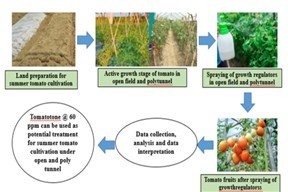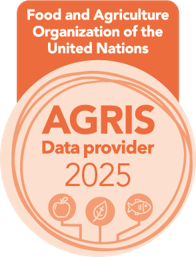Hormonal efficiency and net return of BARI Tomato-4 enhanced under polytunnels during rainy summer season
Abstract
An experiment was conducted at the department of Horticulture, Bangabandhu Sheikh Mujibur Rahman Agricultural University, Gazipur, Bangladesh to evaluate the benefit cost ratio of summer tomato variety BARI tomato 4. The experiment was laid out in a split plot design with 18 treatments and three replications by maintaining a spacing of 60 cm x 40 cm. It comprised of two cultivation method as main plot viz. Open cultivation (P0) and Cultivation under poly tunnel (P1) and nine levels of growth regulators as sub-plot viz. T0 (Control), T1 (GA3@30 ppm), T2 (GA3@60 ppm), T3 (NAA @30 ppm), T4 (NAA @60 ppm), T5 (MH @30 ppm), T6 (MH @60 ppm), T7 (Tomatotone @30 ppm) and T8 (Tomatotone @60 ppm). Application of growth regulators was influenced in all studied parameters over control. Majority of the parameters responded better with the increased concentration of growth regulators. Tomatotone @ 60 ppm gave the highest yield per hectare (5.38 and 20.82 t) under open and poly tunnel condition, respectively. In open and poly tunnel condition, tomatotone @ 60 ppm showed the highest profitability and benefit cost ratio 1.16: 3.19, respectively. Despite of poly tunnel was being costly to establish (41% of total input cost), but it gave 3-4 times higher economic return. Higher values in respect of economy were obtained from the plants cultivated under poly tunnel with tomatotone @60 ppm. Therefore, tomatotone @ 60 ppm can be used as potential treatment for summer tomato cultivation under open and poly tunnel conditions to get highest profitability.
Keywords:
Benefit cost ratio, Economic analysis, Growth regulators, TomatoDownloads
References
Abdalla, A. A., & Verkerk, K. (1968). Growth, flowering, and fruit set of the tomato at high temperature. Netherlands Journal of Agricultural Science, 16, 71-76.
Akter, S., Islam, M. S., & Rahman, M. S. (2011). An economic analysis of winter vegetables production in some selected areas of Narsingdi district. Journal of Bangladesh Agricultural University, 9(2), 241-246.
Azad, A. A., Goswami, B. K., Rahman, M., Malakar, P. K., Hasan, M. H., & Rahman, M. H. H. (2017). Krishi Projukti Hatboi (Handbook of Agro-technology). 7th Edition, Bangladesh Agricultural Research Institute, Joydebpur, Gazipur-1701, Bangladesh. 134-135.
Baliyan, S. P., Madhava, R. K. S., Baliyan, P. S., & Minable, M. (2013). The effects of 4-chlorophenoxyacetic acid plant growth regulator on the fruit set, yield and economic benefit of growing tomatoes in high temperatures. International Journal of Agricultural. Science & Research, 3(2), 29-36.
BBS. (2015). Yearbook of Agricultural Statistics of Bangladesh. Planning Division, Ministry of Planning, Govt. of the People's Republic of Bangladesh, Dhaka.
BBS. (2016). Yearbook of Agricultural Statistics of Bangladesh. Planning Division, Ministry of Planning, Govt. of the People's Republic of Bangladesh, Dhaka, 302.
Chopra, A. K., Payum, T., Srivastava, S., & Kumar, V. (2017). Effects of integrated nutrient management on agronomical attributes of tomato (Lycopersicon esculentum L.) under field conditions. Archives of Agriculture and Environmental Science, 2(2), 86-91.
Gomez, K. A., & Gomez, A. A. (1984). Statistical Procedures for Agricultural Research (2nd Edn). Int Rice Res. Inst., A Willey International Science Publication., 28-192.
Hasan, M. H. (2011). Production and marketing of tomato in some selected areas of Bangladesh. MS Thesis, Department of Agricultural Economics, Bangabandhu Sheikh Mujibur Rahman Agricultural University.
Karim, M. R., Rahman, M.S., & Alam, M. S. (2009). Profitability of Summer BARI Hybrid Tomato Cultivation in Jessore District of Bangladesh. Journal of Agricultural Rural Development, 7(1&2), 73-79.
Kumar, P., Eid, E. M., Taher, M. A., El-Morsy, M. H. E., Osman, H. E. M., Al-Bakre, D. A., Adelodun. B., Abou Fayssal, S., Goala, M., Mioč, B., Držaić, V., Ajibade, F. O., Choi, K. S., & Kumar, V., & Širić, I. (2022). Biotransforming the spent substrate of shiitake mushroom (Lentinula edodes Berk.): A synergistic approach to biogas production and tomato (Solanum lycopersicum L.) Fertilization. Horticulturae, 8(6), 479. https://doi.org/10.3390/horticulturae8060479
Rahman, M., Haque, A., & Mostofa, M. G. (2015). Effect of GA3 on Biochemical attributes and Yield of Summer Tomato. Journal Bioscience Agricultural Research, 03(02), 73-78.
Salunkhe, D. K., Desai, B. B., & Bhat, N. R. (1987). Vegetable and flower seed production. Is’. Edn. Agricole pub, Acad., New Delhi, India, 135.
Zaman, M. M., Huq, A. S. M. A., & Chowdhury, M. J. A. (2006). Production Potentiality of Summer Tomato in Jamalpur Region. International Journal of Sustainable Crop Production, 1(2), 12-15.

Published
How to Cite
Issue
Section
Copyright (c) 2024 Agriculture and Environmental Science Academy

This work is licensed under a Creative Commons Attribution-NonCommercial 4.0 International License.

